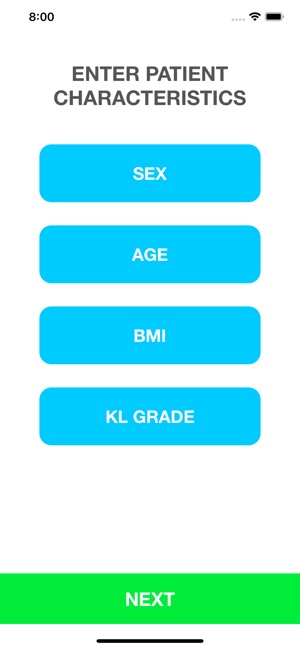價格:免費
更新日期:2019-05-01
檔案大小:15.6 MB
目前版本:1.0.2
版本需求:需要 iOS 12.1 或以上版本。與 iPhone、iPad 及 iPod touch 相容。
支援語言:英語

Through the app, clinicians or researchers can monitor how a patient’s relative level of performance on objective physical function tests differs throughout the course of rehabilitation. Additionally, researchers trying to improve physical function in individuals with knee osteoarthritis can use OAFunction as a tool for eligibility criteria for clinical trials. Currently, research subjects may be selected into a clinical trial based on a physical function cutoff that is the same for everyone. However, OAFunction can be used to set a threshold based on a patient-specific level of physical function and allow researchers to include patients with a specific amount of physical function, which may improve the outcomes of clinical trials.
The simple and intuitive layout allows users to easily enter important patient characteristics and performance results of common clinically-accessible physical function tests. Available patient characteristics currently include: sex, age, knee osteoarthritis severity (i.e., Kellgren-Lawrence Grade), and body mass index. Current objective physical function tests include: 20-meter walk speed, chair stand speed, and 400-meter walk time.

After entering the patient characteristics and physical function test performance, OAFunction automatically determines a patient’s relative level of physical function based on reference values from a large study of individuals with and at risk for knee osteoarthritis (i.e., The Osteoarthritis Initiative). A patient’s relative level of physical function will range from minimum to maximum in 10% increments. For example, a relative level of physical function of 70-80% on 20 meter walk speed indicates that this individual walks at a pace that is faster than 70% of individuals with similar patient characteristics.

OAFunction allows for healthcare professionals to select from two to up to all four participant characteristics to be taken into consideration when determining an individual’s patient-specific level of physical function. For example, a researcher could select “age” and “sex” if they were interested in how a subject compared to individuals with the same sex and within a 5-year age range. Additionally, if a clinician wanted a more nuanced view of a patient’s physical function, they could select all patient characteristics to determine an individual’s relative function compared to a group of individuals with similar sex, age, severity of knee osteoarthritis, and body mass index. The intuitive slider display that indicates relative level of physical function allows the health care professional to select or deselect any combination of patient characteristics, which can be used to see how the patient-specific level of physical function differs depending based on various combinations of patient characteristics.
支援平台:iPhone, iPad
